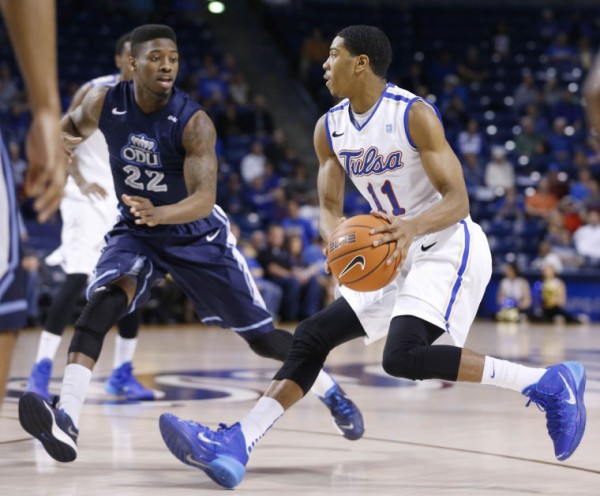Tulsa’s Shaquille Harrison Defines Throwback Guard
Posted by Mike Lemaire on January 21st, 2015If you spend enough time mining websites like KenPom.com and Hoop-Math.com for statistical oddities, you are bound to find some numbers that just don’t jibe with your understanding of college basketball and its players. For example, the season that Tulsa’s Shaquille Harrison is having isn’t just at odds with everyone’s understanding of what makes for an effective shooting guard, it is nearly unbelievable. If the season were to end today, there is little doubt that Harrison would be a first team all-AAC performer. The junior has been the best player on the only undefeated team in conference play and he is probably in the mix for conference Player of the Year honors as well. He is fourth in the conference in scoring (15.4 PPG), eighth in assists (3.3 APG), second in steals (1.8 SPG), and he is shooting 48.9 percent from the floor — combining for a solid Offensive Rating of 108.9. Amid all of those impressive numbers, it is his shooting percentage that deserves the most attention because Harrison has done it without the benefit of a serviceable jump shot.

Harrison Is One Of The Best Offensive Players In The AAC, Only He Can’t Shoot. (James Gibbard/Tulsa World)
In his first two seasons with the Golden Hurricane, Harrison was a volume scorer who occasionally filled up the box score. This season, however, he has transformed into a much more efficient offensive player without changing his style of play, which is noteworthy because he doesn’t play like a stereotypical two-guard. Frank Haith said it best after Harrison contributed 18 points on 5-of-9 shooting in a an early January win over Houston. “He is so good off the dribble. Everyone plays him the same way, they play him for the drive,” the head coach said. “And he still drives it.” Coaches are prone to exaggeration but in this case Haith might be downplaying just how often Harrison “drives it.” Consider this comparison: According to Hoop-Math, 67.4 percent of Duke freshman Jahlil Okafor’s shot attempts come at the rim. This makes great sense because Okafor is a 6’10” athletic marvel who is probably the best big man in college basketball. Harrison, on the other hand, is a lanky 6’4″ combo guard who typically would be jacking three-pointers, but instead takes a whopping 68.2 percent of his shots at the rim. Let that sink in for a second. A combo guard from a perimeter-oriented team is taking more shots at the rim than one of the best offensive big men in recent college basketball history. It’s certainly not what a modern combo guard’s shot distribution is supposed to look like, but what’s especially crazy is that the strategy is working very well for Harrison and his team.
Take a look at shot distributions for most efficient combo guards in the country and you will see what an outlier Harrison is. Teammate James Woodard is only slightly more efficient than Harrison at the guard position (112.1 ORtg), but more than half of his shots come from behind the three-point line (16.5% at the rim). UC Davis’ Corey Hawkins is one of the most efficient combo guards in the country (122.4 ORtg), but only 23.4 percent of his shots come at the rim. Washington State guard DaVonte Lacy has a nearly identical profile to Harrison in terms of usage and offensive rating, but he takes only 18.2 percent of his shots at the rim. This is the typical profile for a highly efficient shooting guard. It’s not that these players cannot attack the hoop; it’s just that they are also excellent shooters, and for them, a 21-foot three-pointer is a very efficient shot. This is what sets Harrison’s profile apart, because by nearly every statistical measure, he can’t shoot a lick.
His 26 percent accuracy this season is in line with his career average on three-pointers, and his 23 percent shooting on two-point jumpers is also on point. He isn’t a shooter, but he understands that limitation, preferring to drive into the lane and find the basket from close range (over 60 percent of shots for his career). The season’s improvement is that he is making a higher percentage of those shots (61.2 percent), but he is also turning the ball over less frequently and seems to relish contact in the paint, drawing fouls at the same rate as the 6’11” Okafor, putting the 6’4″ Harrison among the top 50 nationally in getting to the line. Given his team’s offensive struggles (Tulsa ranks 140th nationally in offensive efficiency), though, AAC defenses are likely to pack it in on him, forcing Harrison to fight through traffic to get his points as the season wears on. It remains to be seen if the unique junior can maintain his level of play, but it will remain fun watching him buck conventional wisdom on what offensive efficiency from the shooting guard in college basketball is supposed to look like.









































